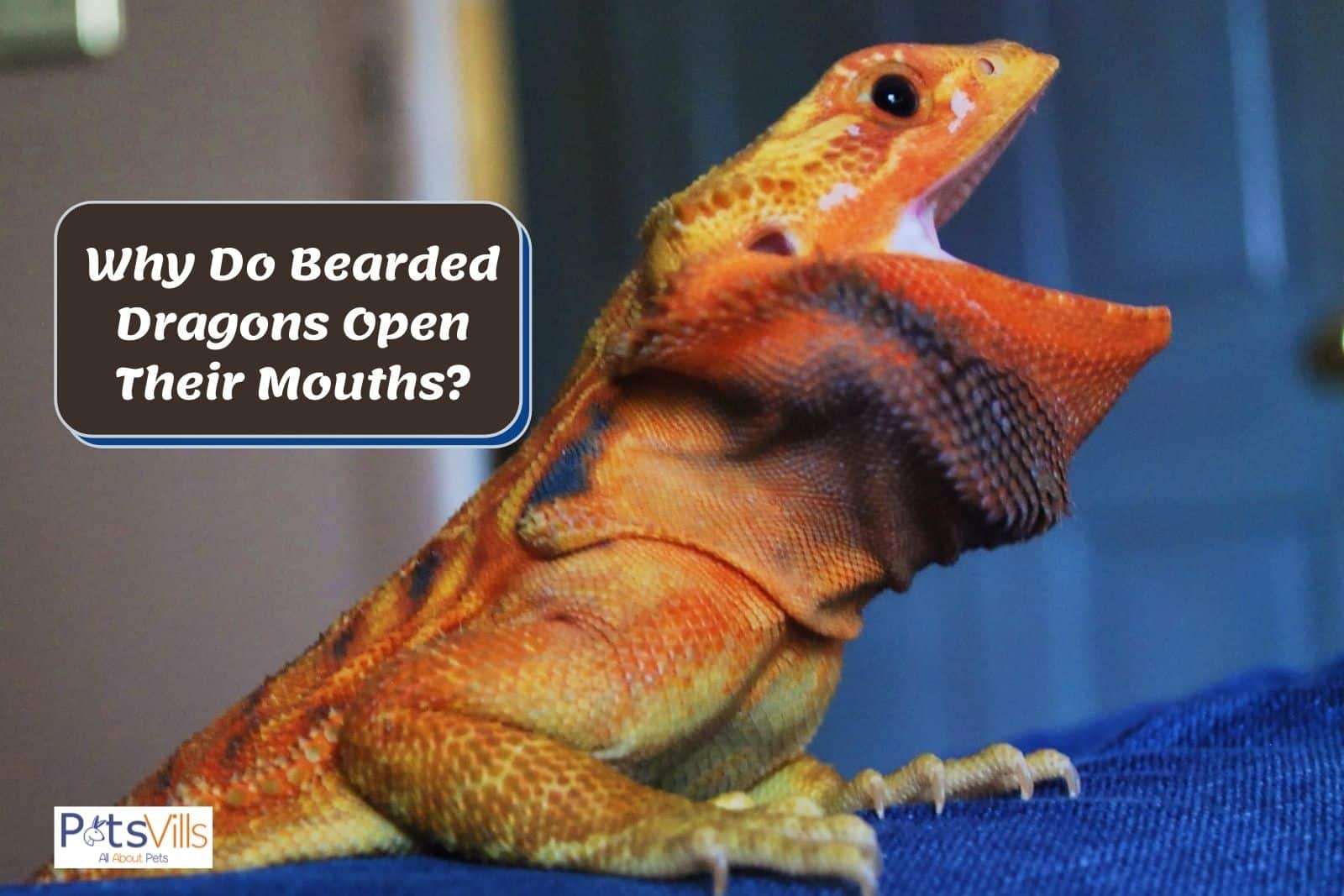Wondering about the reasons why bearded dragons’ mouths open? Look no further!
As a reptile expert, I understand the concern that arises when you see your beloved pet with its mouth agape.
Through extensive research, I’ve identified 7 reasons behind this behavior: temperature regulation, incorrect temperature reaction, defensiveness, stretching, presence of respiratory infection, response to other bearded dragons, metabolic bone disease, shedding, and yawning.
That’s not all – I’ll share my expertise to provide you with a comprehensive understanding of this intriguing behavior and arm you with the required knowledge to care for your beardie effectively!
Table of Contents
Key Takeaways
- Bearded dragons open their mouths for various reasons, including thermoregulation, respiratory issues, stress, mating behavior, impaction, shedding, and yawning.
- Some behaviors, like gaping for thermoregulation or yawning, are completely normal and not a cause for concern.
- However, if you suspect your bearded dragon is experiencing respiratory issues, stress, or impaction, consult a reptile veterinarian immediately.
READ MORE: Do Bearded Dragons Sleep in the Dark?
Here’s a quick video recap.
Without further ado, here are the 7 reasons you must know about…
7 Reasons Bearded Dragons Mouths Open – And What You Need To Know
It’s peculiar – I agree – but there’s more to it (here are the 7 reasons)…
1. Regulating Temperature
At first, the answer seems quite simple. Beardies open their mouths because they are getting warm and want to let excess heat dissipate.
However, diving a little deeper into the matter, one finds a bit more to this behavior than just that.
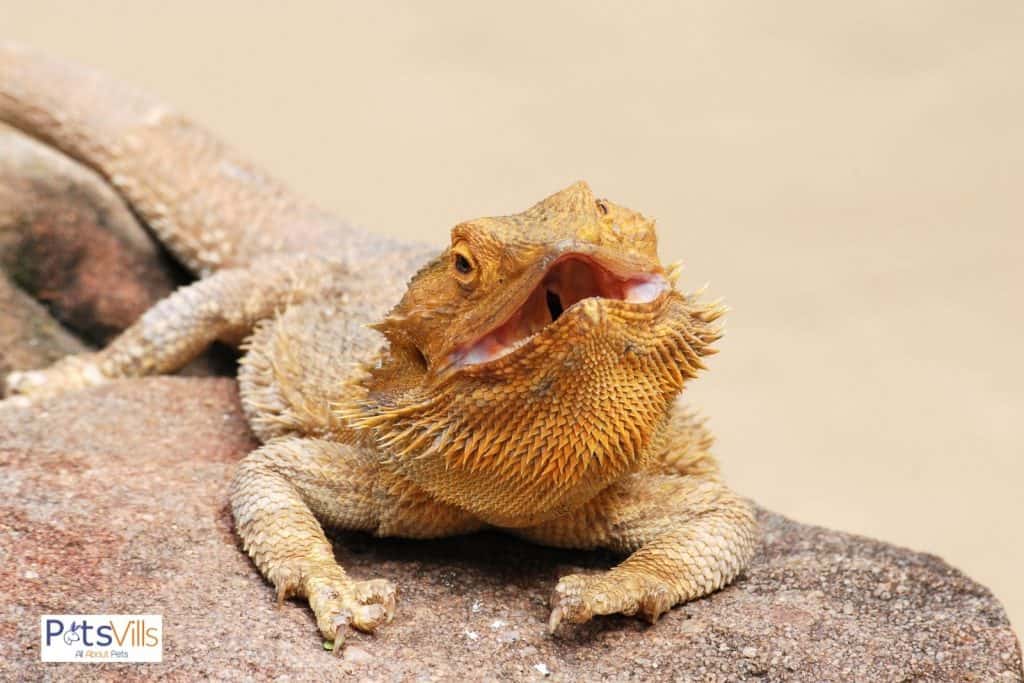
Maintaining the ideal body temperature is the main reason that beardies may sit with their mouths open.
Dragons do not sweat, and much like dogs, their mouths are the easiest way for them to expel extra body heat. [1]
This behavior is not always explicitly to cool down, though. Dragons may open and shut their mouths periodically to maintain an optimal temperature.
If your beardie has its mouth open while basking in the heat, it is most likely heat regulation. This is called “gaping.”
Bearded Dragon Gaping
One of the behaviors they often display is opening their mouth for long periods, also known as “gaping.” Keep in mind that gaping does not necessarily mean that your beardie is getting too hot.
They are likely just maintaining the internal temperature that they are most comfortable with.
However, if your beardy shows signs of discomfort, avoids its heating lamp, or gapes even in hiding, it could be cause for concern.
If you think that your dragon is getting too hot, make sure that parts of its tank act as a ‘thermal’ refuge.
The experienced bearded dragon owner will know that you need to maintain a thermal gradient in your bearded dragon’s tank. The correct temperatures are crucial.
The overall temperature should come to around 95° Fahrenheit. That said, different areas should be at different temperatures to accommodate a beardies needs.
EXPERT TIPS: The basking area should be kept between 95° and 100°F. Your dragon will also need a cool spot with temperatures between 75° and 80°F.
Because bearded dragons are ectotherms, they need lower temperatures to sleep comfortably. Therefore, the ideal temperatures for resting areas are between 70° and 75°F.
If the temperature is even throughout your dragon’s tank, they do not have the reprieve they may need to cool down. Furthermore, they will struggle to sleep.
Beardies need a couple of things to help maintain their body temperature. First, the heat lamp, the main heat source, should be a 40 or up to 75W infrared bulb.
Placing the bulb too close to the designated bearded dragon basking area will cause a beardie to get too hot as well. [2]
CHECK: New MRI Scans Protocol On bearded Dragons Generates A Brain Atlas
2. Stretching
Bearded dragons shed their skin. Young beardies can shed every couple of months. As they mature, beardies shed less frequently.
At full maturity, starting at around 18 months or so, bearded dragons may shed only a couple of times a year.
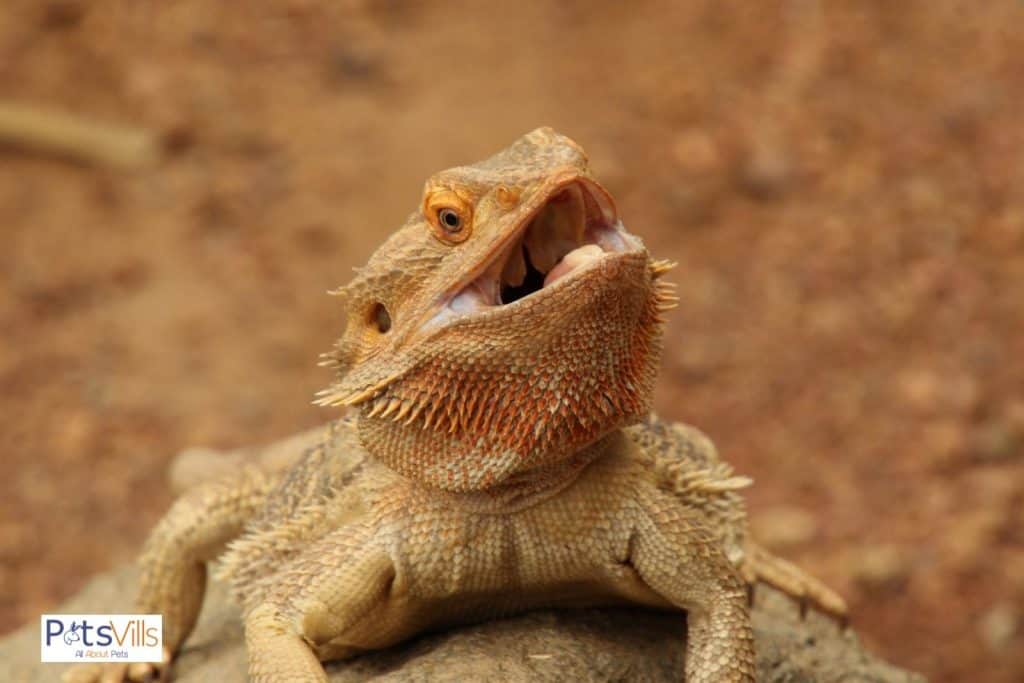
A good beardie stretch helps loosen the skin around the neck area. The behavior is usually accompanied by ‘puffing,’ further loosening skin and preparing the dragon for its next shedding.
Although it is mostly associated with shedding, a dragon may stretch their beard by opening their mouth long before they are due to shed.
This behavior may keep the skin around the beard area supple and prevent it from growing too tight.
3. Aggressive Behavior
Bearded dragon behavior is usually placid. They are not inclined to aggression, given they have enough space to move around in and they don’t have too many other beardies to contend with.
However, they are territorial and can get agitated by several things that we humans might not notice.
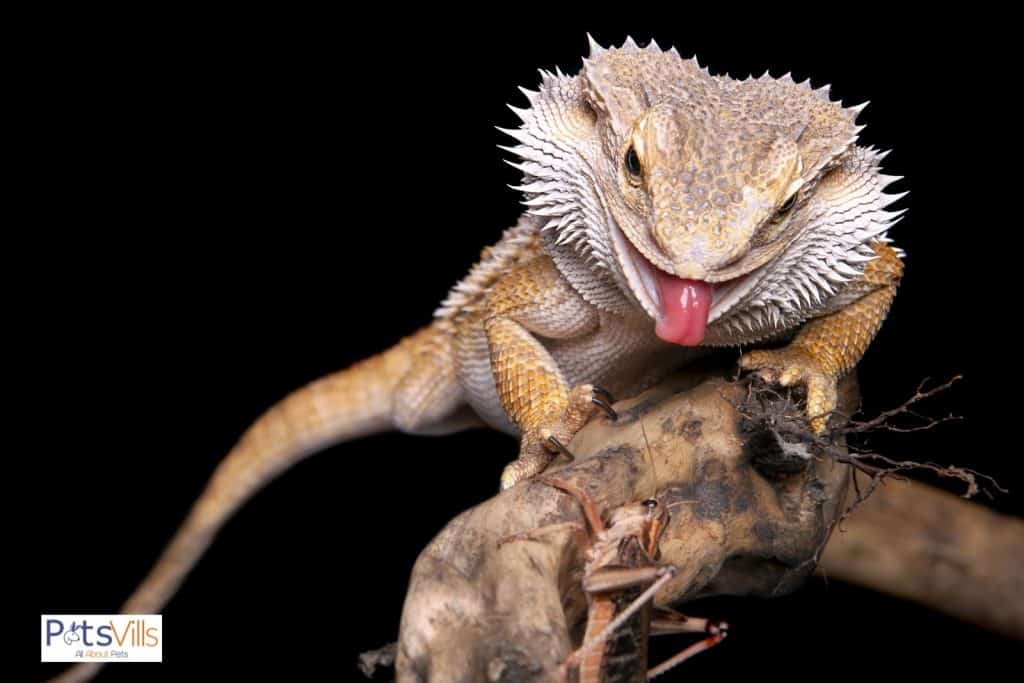
A is more likely to display a submissive hand gesture. However, should one decide to stand its ground, an open dragon mouth is one of the ways they might signal their aggression. bearded dragon standing tall
If you think that your dragon’s open mouth is a sign that they are angry, there are a few other tells you can look for.
For instance, if your dragon is bobbing its head, it clearly indicates that they are asserting dominance.
They are ready to get scrappy if the situation requires it. An open mouth, in addition to the head-bobbing, emphasizes the intent.
A puffed-up or blackened beard, hissing, and a tall stance indicate aggression.
EXPERT TIPS: To help your beardie manage their aggression, provide them with enough hiding places where they can go to calm down.
CHECK: Bearded Dragon Sitting With Mouth Open
Several things could trigger your dragon’s aggression. It helps to understand these so that you can identify the reason that your dragon has its mouth open and help if needed:
Fellow Bearded Dragons
Beardies are solitary animals. In nature, they form loose groups but don’t share the cooperative behavior we associate with social animals.
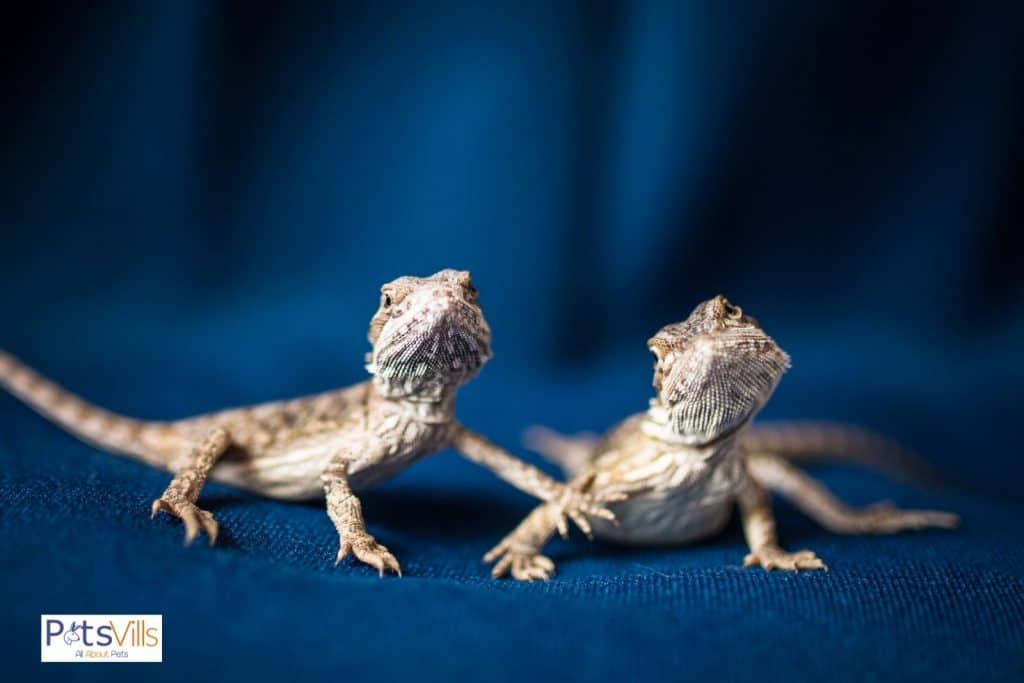
While they can tolerate each other, they do require a period of time to themselves.
When challenged, they will put on displays of dominance and try to outsmart their new rival.
For example, a submissive dragon will ‘wave’ their arm to show that it will not take the challenger up on the threat.
Suppose the challenged beardy is confident that they measure up to the challenger. They may then open their mouth and display clear signs of aggression.
The submissive beardy may do better in their separate tank.
EXPERT TIPS: If your dragons display this behavior, you may need to separate them. This may extend as far as placing the dragon tanks in separate rooms. However, aggression can continue if they still see each other.
READ MORE: Do Bearded Dragons Bite?
Defensive Behavior
Let’s break down defensive behavior a bit more by looking at the potential causes behind it.
Other Animals
Bearded dragons will usually exhibit a fear response to larger animals. This entails their classic waving gesture, displaying their submission.
Unfortunately, this gesture does not communicate a sign of stress to the excited dog or curious cat.
Undeterred by the submission, other animals might continue to upset a dragon, either through their actions or by the noise they make.
That leaves a beardy little choice. In a situation where they feel particularly threatened and don’t feel safe retreating to the safety of a hiding spot, they must defend themselves.
It starts with more beardie body language.
An open mouth, combined with hissing and any other combination of displays of bearded dragon aggression, soon follows.
At this point, your dragon is in full ‘fight for survival’ mode. It may seem a funny sight to behold, but a beardie in this state is suffering extreme stress.
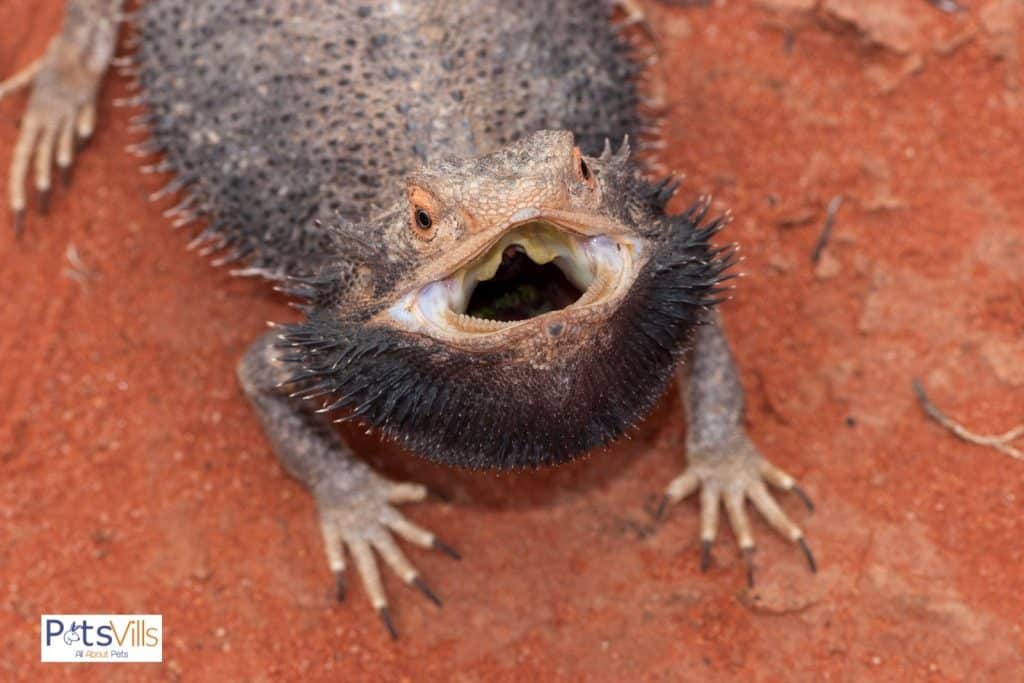
Related: Why Do Bearded Dragons Wave Their Arms?
Children
Children at play can distress our beards greatly. All members of the Pogona family have highly acute hearing. In nature, this helps them steer clear of predators and detect an attack in time to escape.
In captivity, this trait causes bearded dragons to stress. Their sharp hearing alerts beardies to the faintest of sounds.
It’s safe to say that children are not particularly quiet. As a result, beardies can interpret the sound of chaotic play as a serious threat to their well-being.
As is the case with other pets, a dragon will usually choose to retreat to the safety of a hiding spot. Even so, beardies will still experience extreme distress.
Should they feel that the threat is inescapable, they may choose to stand their ground in a desperate attempt to ward off the perceived threat.
In this case, a dragon might hiss, the beard could turn black, and the mouth may be stretched open.
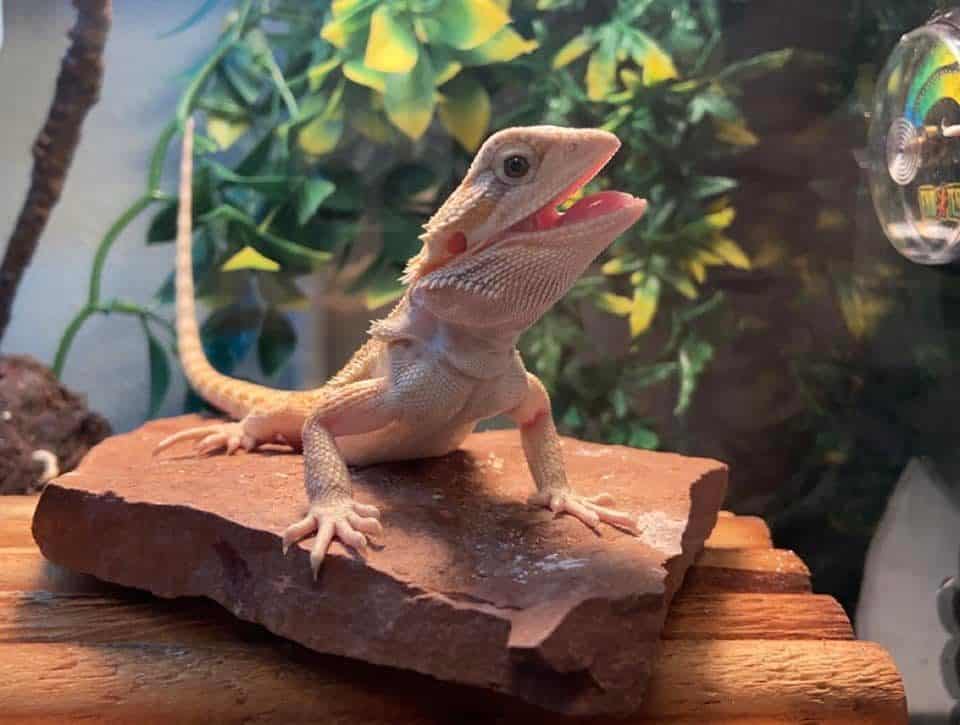
Beardies are not ideal for homes with small children. If you have children, you should place your dragon tank in a room that the kids don’t use for play.
Sound can remain a problem, even in a separate room. It is, therefore, important to try and isolate your beardie from noise as best you can.
If the behavior persists, and you suspect that it is linked to children at play, you might even need to soundproof the room in which your dragon lives.
The final option at your disposal would be to rehome your dragon responsibly.
New Decor
It is difficult not to have a small chuckle when you see a beardy have a hissy fit, mouth gaping at the sight of a new lamp.
Unfortunately, new items around the home can distress a bearded dragon immensely. They are very focused on their surroundings.
New objects don’t usually appear out of nowhere in their natural habitats. So it makes sense that the sudden arrival of new objects can seem strange and potentially dangerous to bearded dragons.
There is no easy way to introduce a beardie to a new item. Sometimes they are not bothered at all by something new. Other times they become utterly obsessed.
While it may not be a solution, you should introduce any new items at as much distance as possible. Then, with time your dragon may become accustomed to the item and accept it as part of its environment.
If your dragon finds something particularly distressing, you might have to move the said item to a different space altogether. If it is a new permanent fixture, you will have to move your dragon.
Keep in mind that moving your beardie is a very stressful experience for them as well.
ALSO READ: Pictures of Bearded Dragons
Window Views
Many bearded dragon owners prefer to place their bearded dragons near an open window. The idea is that your beardy can enjoy the view.
Unfortunately, there are a couple of problems with this. First, regarding your dragons sitting with an open mouth, the suburban outside world offers plenty of things that beardies could see as a threat.
Other pets and children, as well as vehicles, may seem dangerous to your bearded dragon. Birds invoke the strongest reaction. In their natural environment, birds are dragons’ natural predators.
Maintaining your dragon tank is also more difficult when you need to compensate for direct sunlight.
However, the pros don’t justify the cons, especially if you notice your beardy open their mouth more frequently.
4. Mating Behavior
An open mouth is no sign of romantic intent in dragons.
However, you will notice them doing this a lot more often at these times. This is because their hormones cause several behavioral changes, including heightened aggression. [3]
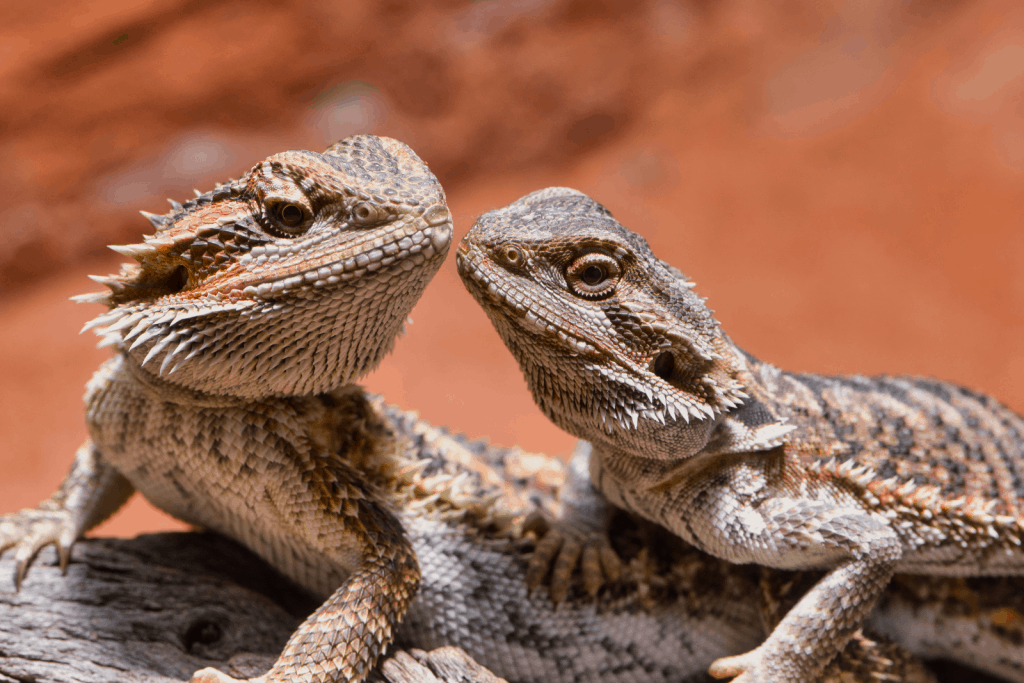
Curiously, a solitary male may still display this sort of behavior with no female or competing males nearby.
Bearded dragons usually mate in the summer months.
So if your beardy opens their mouth a lot more frequently during this time, it may be that they are experiencing the biological responses associated with the time of year.
5. Respiratory Disease
Infection of the respiratory tract is relatively rare in bearded dragons.
The condition is brought on by poor tank ventilation and higher humidity levels over a prolonged period. Most Pogona is used to more dry air.
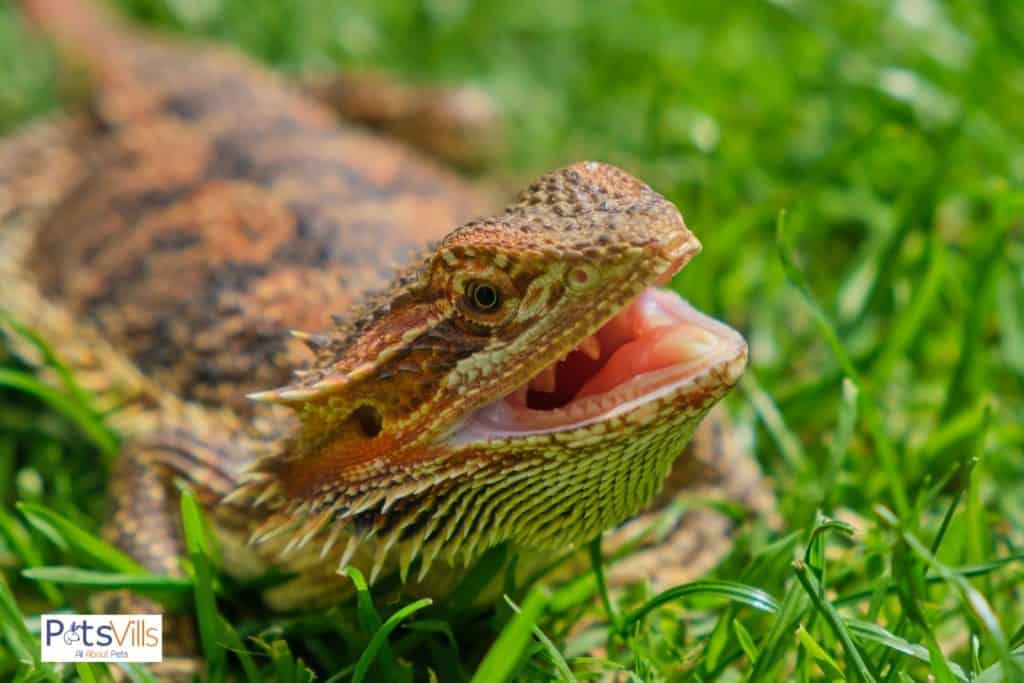
Extended humidity periods can cause a respiratory infection that may be life-threatening in severe cases.
EXPERT TIPS: Keep humidity levels under 35-40%. If you live in a humid area, you may need to use a dehumidifier.
Additional measures include mesh insulation and removing any water-retentive materials such as tree bark. A smaller water bowl kept in the cool area of the tank can help as well.
If you suspect that your beardie might have a respiratory infection, you should immediately take them to a reptile vet.
RELATED: Do Bearded Dragons Have Teeth?
6. Shedding
Shedding is an entirely natural process for bearded dragons as they grow and replace their outer layer of skin.
When your bearded dragon is shedding, its mouth will be slightly open, loosening the skin around its head and jaw area.
Why? This action not only facilitates the removal of old skin but also makes the process more comfortable for your beardie.
During shedding, it’s crucial to maintain appropriate humidity levels in your bearded dragon’s habitat.
Doing so can help the shedding process go smoothly.
To further aid in rubbing off the shedding skin, provide your bearded dragon with a rough surface, like a rock or branch.
Last, watch your beadie like a hawk to ensure it sheds properly and doesn’t develop any complications, such as a retained shed, which can lead to health issues.
7. Yawning
Another reason you might see your bearded dragon with its mouth open is yawning.
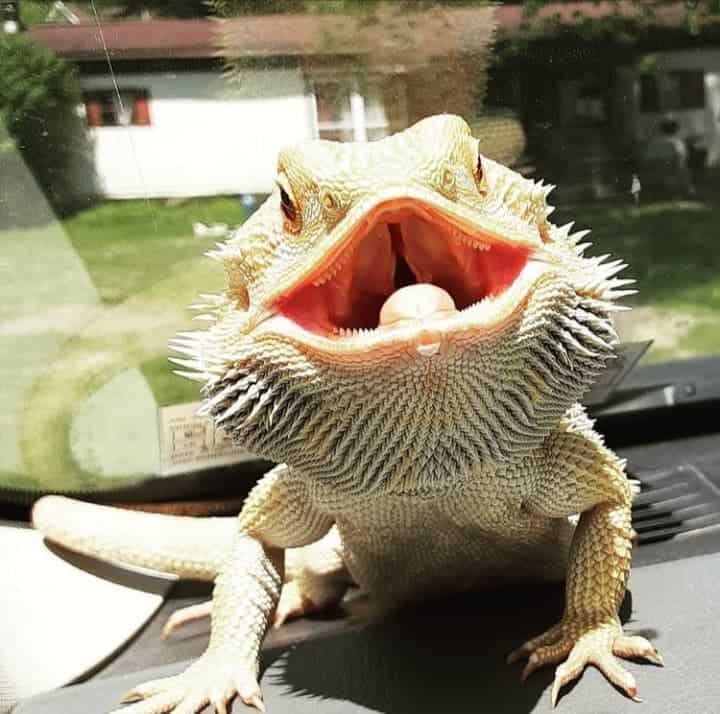
Like many other animals, bearded dragons yawn naturally, signaling that your pet might be tired or wake up from a nap.
Researcher Bayard H. Brattstrom explains, “The opening of the mouth in bearded dragons may serve multiple functions, including thermoregulation, social signaling, and maintenance behaviors such as licking, drinking, and yawning. [1]”
Yawning can also help regulate the pressure within the bearded dragon’s eardrums and promote proper airflow.
Occasional yawning is no cause for concern; however, if you notice excessive yawning, it might indicate an underlying health issue or discomfort in the habitat.
In such cases, evaluate your pet’s environment—temperature, humidity, and cleanliness—to ensure it meets their needs.
Does the problem persists or worsens?! If “yes,” I suggest that you consult a reptile veterinarian for professional advice.
Understanding these behaviors and providing proper care will help your bearded dragon thrive in its environment, ensuring a healthy and happy pet.
With proper attention and a suitable environment, your beardie will thrive – plus, you can enjoy a healthy, happy pet…
Infographic
For a summary, refer to this infographic and discover why your beardie has its mouth open:

Have you ever stuck out your tongue as a little kid? It was because you were angry, but what about your beardie? Let’s find out!
Why Is My Bearded Dragon Sticking Its Tongue Out? (3 Common Reasons)
You might recall sticking out your tongue as a child to express certain emotions, but what about bearded dragons? As a seasoned beardie owner, I’ve discovered 3 reasons:
1. Tasting the Air: Exploring Their Environment
Bearded dragons use their tongues to gather information about their surroundings.
By sticking out their tongues, they can detect scents and identify potential food sources. This natural behavior showcases their curious nature and keen sense of smell.
2. Drinking: Quenching Their Thirst
Another reason your beardie might stick its tongue out is to collect water droplets.
Bearded dragons often do this when they’re being misted or encountering moisture in their environment. It’s a unique way for these reptiles to stay hydrated!
3. Shedding: Loosening the Skin Around Their Mouth
As you’ve seen above, bearded dragons open their mouths while shedding – but they’ll go one step further: they’ll stick out their tongues.
Actually, they’ll use their tongue to loosen the skin around their mouth, making the shedding process easier.
Now that you know the ins and outs of these behaviors, let’s delve into some frequently asked questions.
FAQs
#1 Can bearded dragons indicate happiness by opening their mouth?
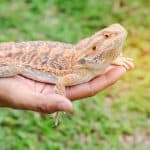
No, it’s not a direct sign of happiness. It could mean they’re regulating temperature or showing aggression/distress.
#2 How to tell if a bearded dragon is happy?
Signs include no aggression, basking, comfortable being held, non-puffed up, non-hissing, non-waving in fear, good diet, healthy weight, and comfortable living space.
#3 Is it harmful when a bearded dragon opens its mouth?
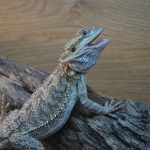
No, it’s usually not harmful. It’s usually to regulate temperature but could indicate aggression/distress or respiratory infection in rare cases.
Conclusion
If you’ve wondered why bearded dragons’ mouths open, you’re now armed with all the knowledge you need – but here’s the short of it:
Bearded dragons keep their mouths open for several reasons. First, they do this while basking to regulate their body temperature.
It is also a common sign of aggression, especially when displayed alongside other aggressive behaviors.
Like humans, they too can be hostile to competition and rivalry – so an open mouth can help them scare off competition by making them appear more frightening…
In rare cases, an open mouth can indicate a respiratory infection.
Don’t be too alarmed if you notice your beardie’s mouth is open – Instead, try to understand why your bearded dragon’s mouth is ajar and address the issue if needed.
References
1. Brattstrom BH. Social and Thermoregulatory Behavior of the Bearded Dragon, Amphibolurus barbatus. Copeia. 1971;1971:484.
2. de Vosjoli P. Colorado Reptile Humane Society Guide to Caring for Bearded Dragons, updated 2015 [Internet]. 2015. Available from: https://www.corhs.org/uploaded/89bfcdf0397c3e18c1dff810553f6336_CoRHS_Bearded_Dragon_Care_GuideCURRENT.pdf
3. Dickerson AL, Rankin KJ, Cadena V, Endler JA, Stuart-Fox D. Rapid beard darkening predicts contest outcome, not copulation success, in bearded dragon lizards. Animal Behaviour. 2020;170:167–76.
4. Cannon MJ. Husbandry and veterinary aspects of the bearded dragon ( pogona spp. ) in Australia. Seminars in Avian and Exotic Pet Medicine. 2003;12:205–14.
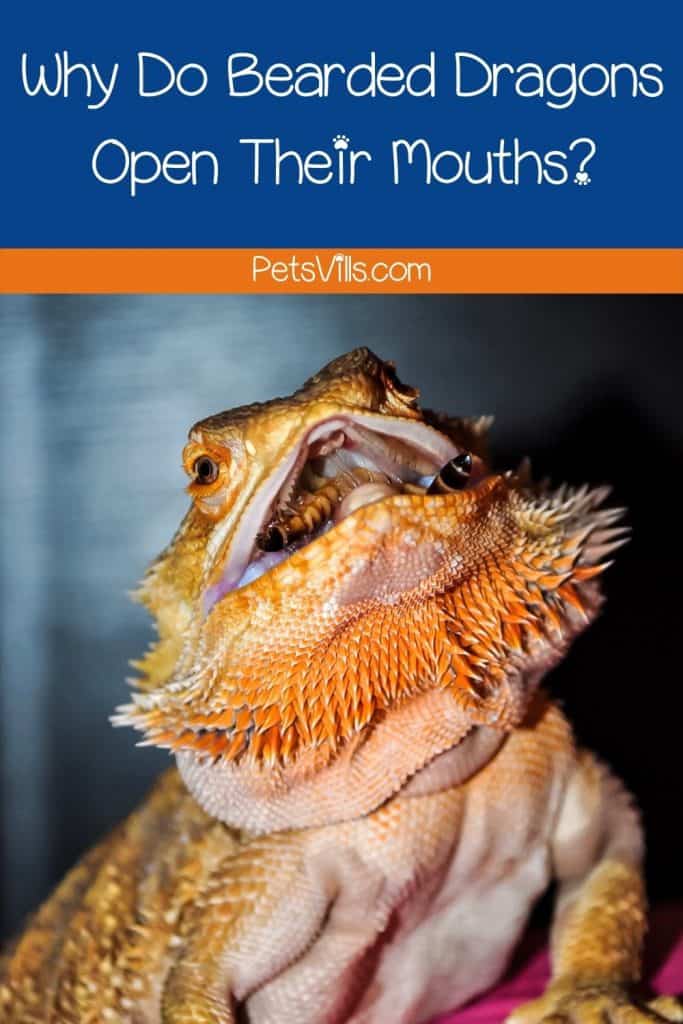
Have you seen your bearded dragon opening his mouth? Let us know in the comments below!

